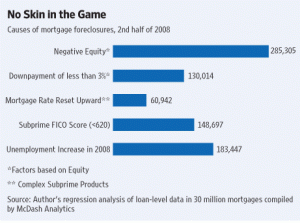There is a kind of weird OpEd in today’s WSJ by Stan Liebowitz. The professor makes the incredible discovery that zero down payments, 100% LTV financings tend to slide in great numbers into foreclosure:
“What is really behind the mushrooming rate of mortgage foreclosures since 2007? The evidence from a huge national database containing millions of individual loans strongly suggests that the single most important factor is whether the homeowner has negative equity in a house — that is, the balance of the mortgage is greater than the value of the house. This means that most government policies being discussed to remedy woes in the housing market are misdirected.”
This is analysis by gross over-simplification. Not quite reductio ad absurdum, but close. Unfortunately, it leads to conclusions that are at best only partially correct.
And that conclusion? The problem has been Prime, not sub-prime loans:
But the focus on subprimes ignores the widely available industry facts (reported by the Mortgage Bankers Association) that 51% of all foreclosed homes had prime loans, not subprime, and that the foreclosure rate for prime loans grew by 488% compared to a growth rate of 200% for subprime foreclosures. (These percentages are based on the period since the steep ascent in foreclosures began — the third quarter of 2006 — during which more than 4.3 million homes went into foreclosure.)
Here is where things get weird: I can’t verify many of these data points. They don’t square with the data I review via RealtyTrac or Mortgage Bankers Association or Bloomberg. (I assume the professor meant we had 4.3m foreclosures since Q3 2006, not during).
As to prime versus sub-prime, it appears the Mortgage Bankers Association, data dispute the professor’s. Jay Brinkmann, chief economist for the MBA, noted in May 2009 that in 2008, prime, fixed-rate loans were only 19% of foreclosure starts nationwide, while Subprime adjustable-rate mortgages were 39%. More recently, the two levels have come together: prime loans are up to 29% of foreclosure starts while subprime adjustables came down to 27%.
But reporting only in percentages can be misleading. As Floyd Norris noted in , “There are far more prime mortgages than subprime, of course, and subprime loans are much more likely to get into trouble. But this does show how the foreclosure problem is spreading.”
Agreed.
But the claim that during this crisis it has been Prime and not Subprime is simply unsubstantiated by the timeline or data. Subprime went bad first, then Alt-A, and then prime followed it later. Sub-prime and Alt-A went bad due to poor lending standards; Prime went bad in part due to job losses and as the economy got worse.
If anything, there is a stronger argument to make that the problem is worse from 30 year fixed versus ARMs. Here is the MBA data from September 2008:
For prime loans, foreclosure starts on fixed rate loans were 0.34 percent, an increase of five basis points, while prime ARM foreclosure starts were 1.82 percent, a 26 basis point increase. For subprime loans, fixed rate foreclosure starts increased 27 basis points to 2.07 percent and subprime ARM foreclosure starts increased 31 basis points to 6.63 percent
Sub-prime worse than Prime, ARMs much worse than fixed.
Of course, it is true that 100% LTV mortgages are a problem. But you need some context to understand how they came about. And while the professor does correctly identify underwater mortgages as a major factor — he seems to place the blame squarely on 100% LTV. Perhaps another question worth exploring is the boom/bust issue: How did those home prices run up so much, only to reverse back towards normal, historical pricing metrics? For that, you need to look at many factors.
A more comprehensive 40,000 foot view would note that 100% LTV is a symptom of the larger problem of a) abdication of lending standards, caused by b) enormous demand for securitized loans, enabled by c) rating junk as AAA, in order to satisfy the demand for higher-yielding, non-junk paper, all of which traces its roots to d) Greenspan’s ultra low interest rates.
Yes, bad lending standards, no money down, lack of income verification or debt servicing ability were key culprits. But to claim that it was more Prime than sub-prime is belied by the history of foreclosures. And, it ignores all the other moving parts to the equation.
>
>
Source:
New Evidence on the Foreclosure Crisis
Zero money down, not subprime loans, led to the mortgage meltdown.
STAN LIEBOWITZ
WSJ, JULY 3, 2009
http://online.wsj.com/article/SB124657539489189043.html



What's been said:
Discussions found on the web: